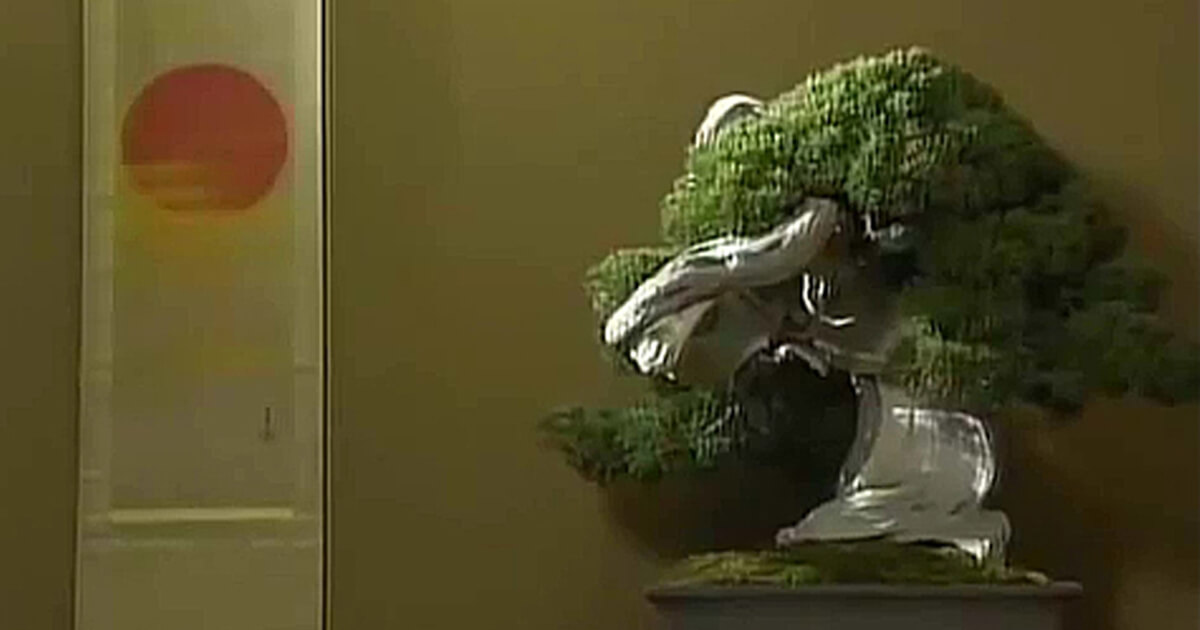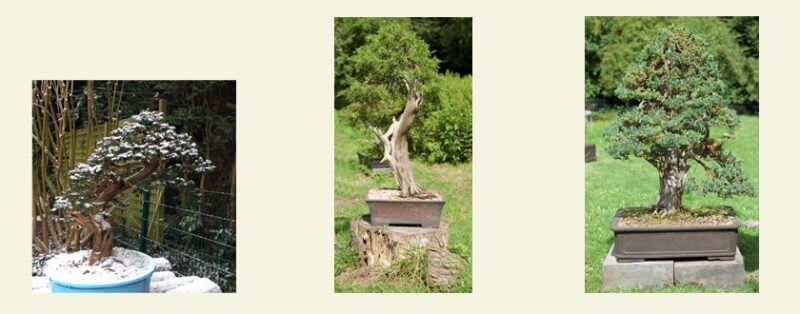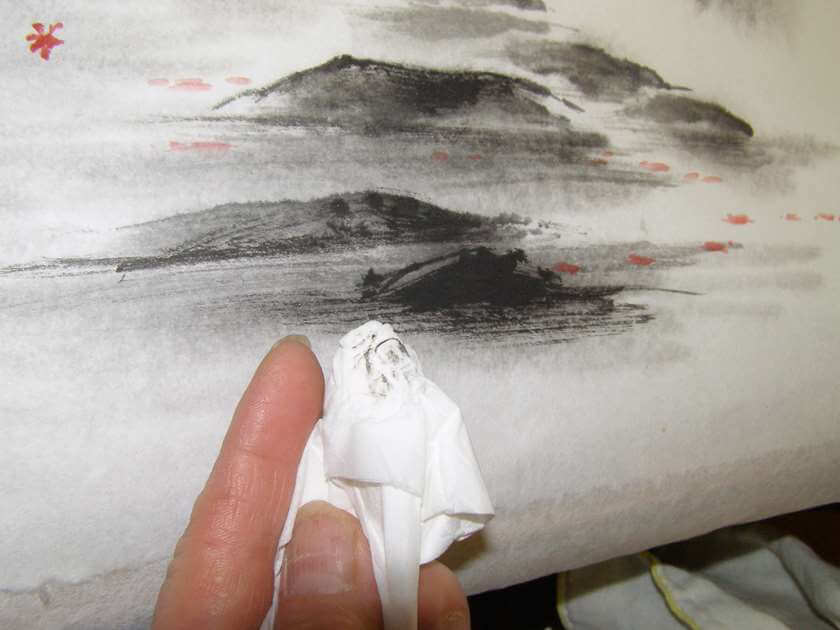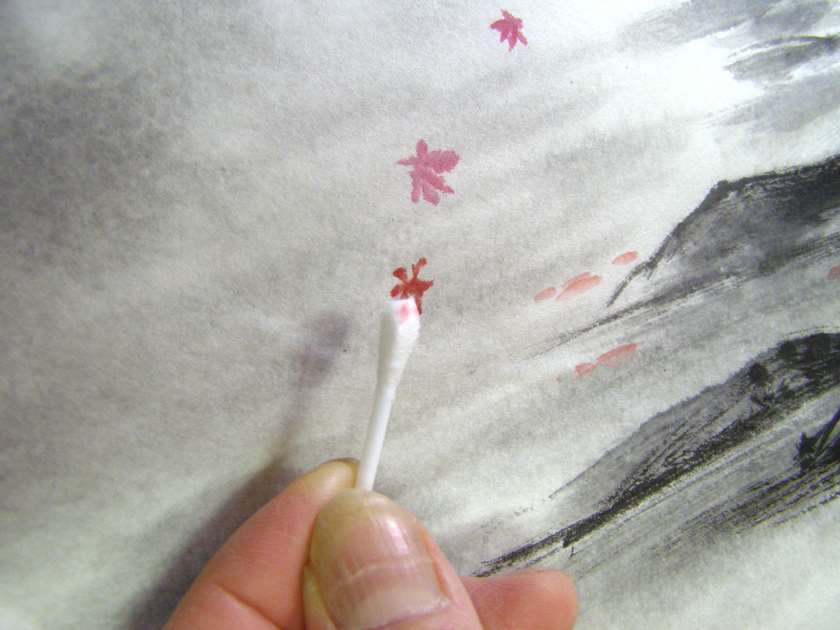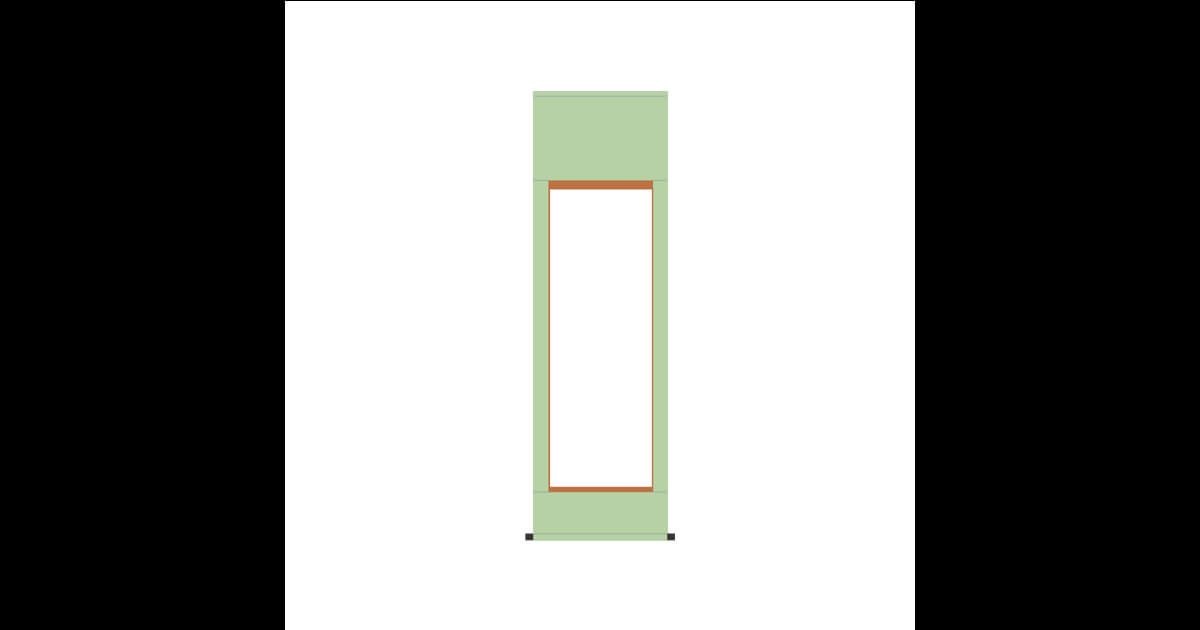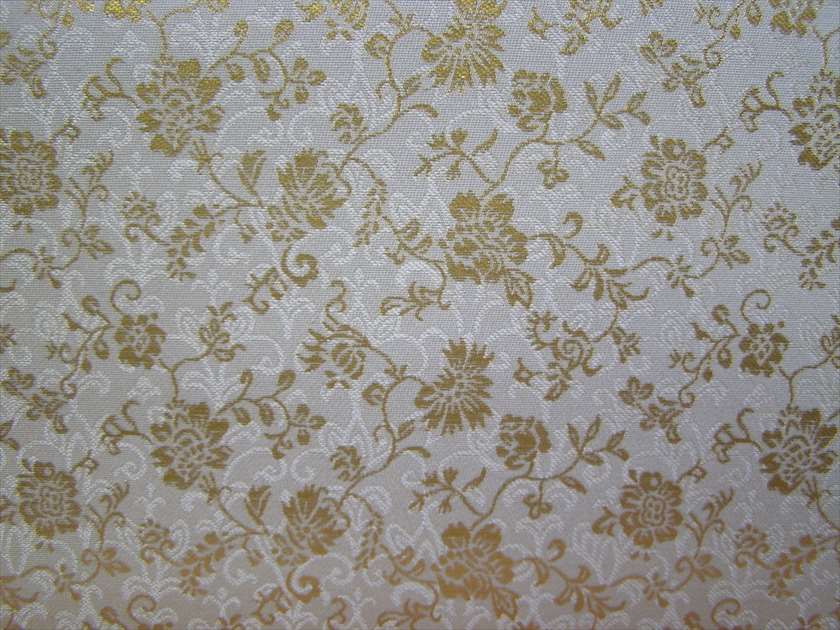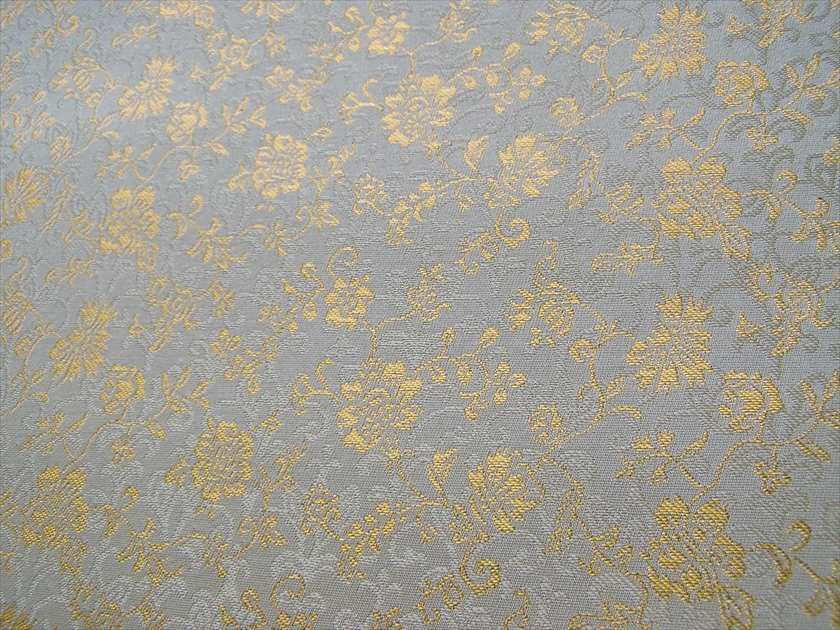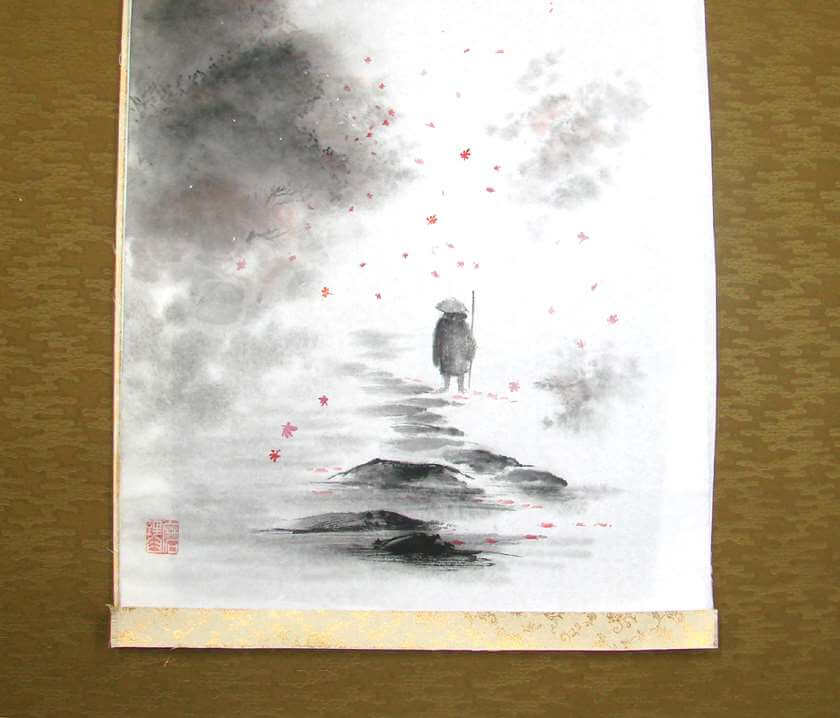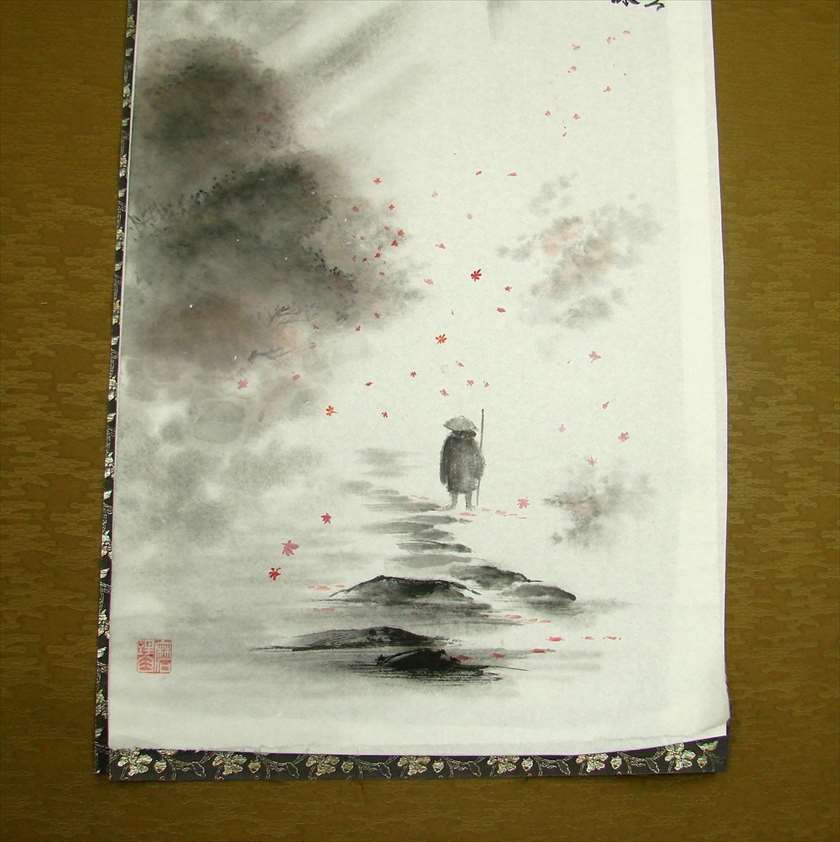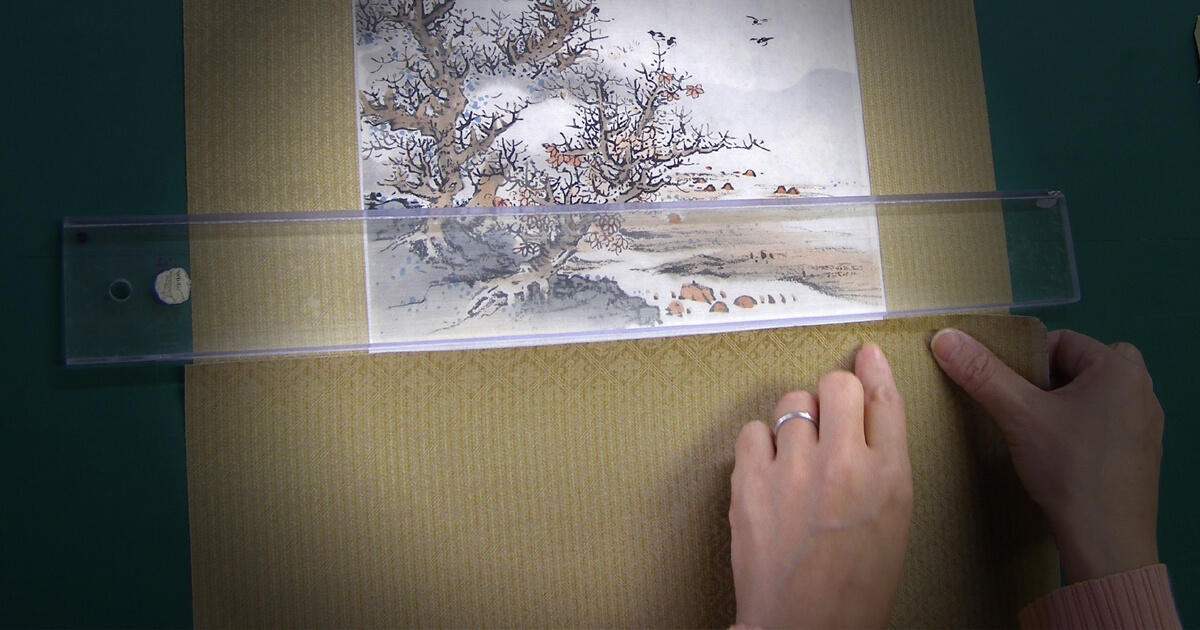Order from Germany for Mounting a Painting into Kakejiku
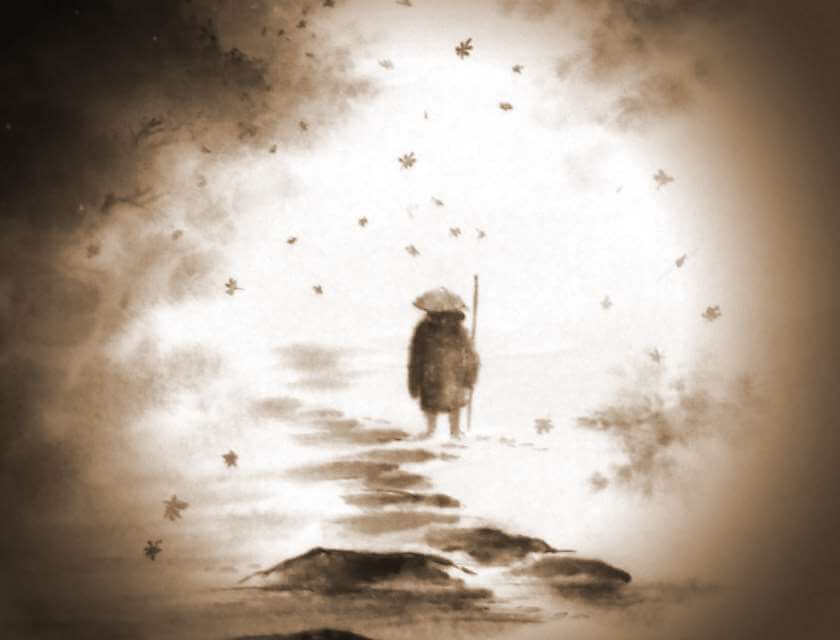
Today, we would like to tell you about a recent international order.
Bonsai with a hanging scroll in an alcove
Referring to our article on the popularity of Bonsai a little while ago, one day, we received an inquiry for our ready-made hanging scrolls from a German client.
As we talk, we found out that his hobby is cultivating Bonsai and what he wanted to achieve was to have an ideal hanging scroll that can be displayed together with his bonsai plants.
Eventually, he came up with an idea to mount his favourite picture into a hanging scroll. We were thrilled to hear his ideas which were so creative.
At first, he had some options for the picture. We talked a lot about the material of the paper, its thickness and the types and kinds of ink and pigments. These are very important elements when making a scroll. This is why we ask every client who are thinking of mounting/remounting artworks to read our cautionary notes about appropriate materials.
Finally, a sumi-e painting was chosen. It is about an autumn scene. We both decided to first check the actual painting at our factory to make sure the painting is suitable for making a scroll. If there is no problem, we can proceed accordingly. If not, we are going to return the painting to him with some samples of Japanese rice paper for checking the appropriate thickness. Upon arrival of the painting, we confirmed it was painted on a thin Japanese paper that is perfect for mounting.
Here is the painting. A very “shibui”sumi-e by an European sumi-e artist.
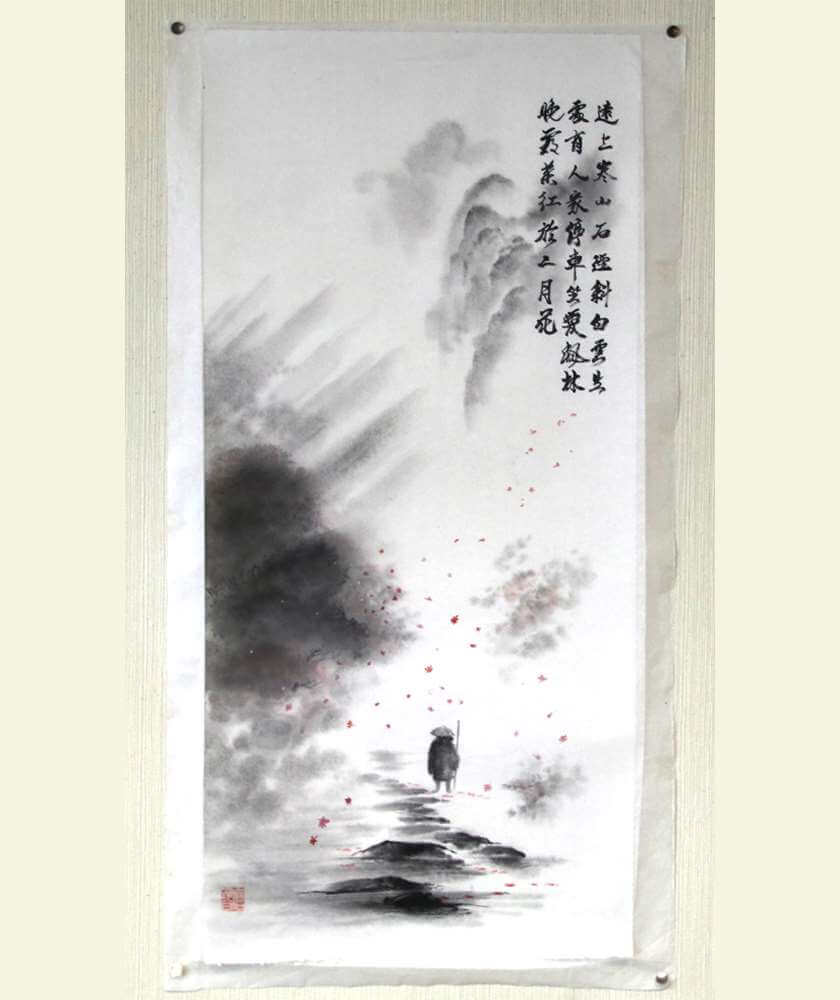
We first thought the painting was from China but found out later that the artist was Mr. Mariusz Szmerdt, a sumi-e ink painter in Poland. There was an artist’s chop in the lower left of the painting and it said「磨理臼」(Ma Ri Usu).
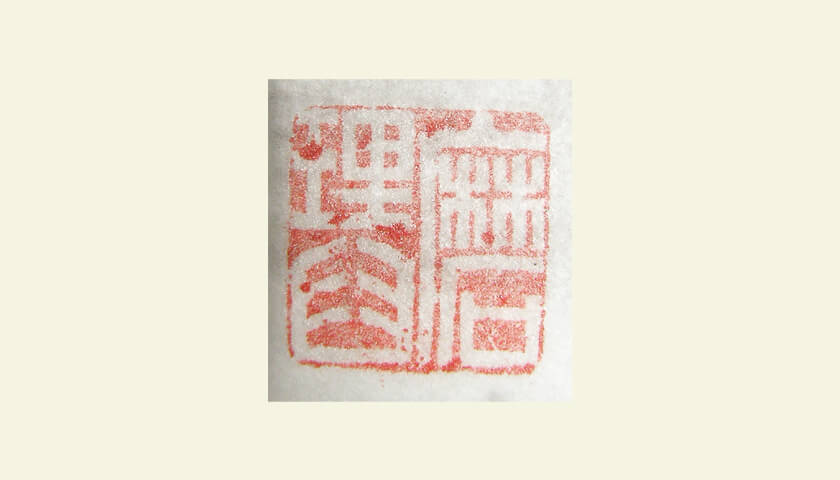
We were pleasantly surprised to be able to mount a Japanese ink painting that is from abroad. Mr. Mariusz is quite skillful. His artworks are tasteful and have a profound atmosphere.
Please visit his website :
To create a perfect combination of bonsai and a scroll in a tokonoma alcove, our client kindly shared some bonsai pictures with us and also had a specific request for the height of the scroll as below :
=Quote=
Concerning the size i would suggest to make the scroll not much larger than 140cm. Usually larger scrolls (180cm or larger) don’t fit into the common size of European tokonomas.
Of course the final length of the scroll could be shorter than 140cm, but 150cm would also be Ok. More important is the aesthetical harmony of scroll and tree. Two trees are 100cm tall. So the size of the scroll should fit to the size of these 2 trees in aesthetic aspects.
For example: If a tree is 60cm tall and the scroll would be 180cm, there would be a dominance of the scroll, which is not so nice. I think 130-140cm should fit and the width of the scroll shouldn’t be too narrow.
Before preparing some mounting images, we found two points to confirm about the painting :
=Quote=
+ The art work has been already attached a Japanese backing paper.
The backing paper is very lightly attached and now partially coming loose from the art work. Thus, before mounting, we need to take off the backing paper to finish the scroll in a perfect condition.
+ The possibility of being “blur” for painting & calligraphy.
It seems that the artwork is from China. For both painting and calligraphy, pigments are used instead of Japanese sumi ink. Sumi ink contains animal glue and adheres well to the paper and do not ink bleed easily. On the other hand, pigments used for this picture does not contain much glue so it easily gets bleed, which means that there is the possibility of pigments bleeding because we use water during the mounting procedure. Please see the following pictures for your reference.
How we check if the ink and pigments will likely bleed : Slightly moist the cotton buds/tissue with water and touch the picture to see how well the ink or pigments adhere to the paper. The pigments came off easily when we did this checking. We will take our very best efforts to prevent color bleeding. It takes a longer lead time and some extra cost for a special chemical we use. Even if we take any means available, there is still the possibility that some color bleeding may occur so we hope to have your kind understanding and acceptance for this issue.
The color/ink bleeding issue happens to a lot of Japanese clients too. There are two types of sumi ink. One is produced by grinding sumi ink stick with cold water. The other is a ready-made liquid sumi ink. The latter contains less animal glue so will likely bleed easily during the mounting procedure. It is difficult for us to judge the type of sumi ink by their appearances so we do this simple test to confirm its type. Although we do everything to prevent color bleeding, we are not able to say it is 100% safe. This is why we explain to our clients that there still remains a risk before starting work. Please refer to Ink stick : https://en.wikipedia.org/wiki/Inkstick
Thanks to kind acceptance on these matters from the client, we went on preparing mounting images.
Sample Images of Hanging Scrolls Mounting
We proposed three mounting samples that are all in a literati/Maru mounting style.
Fabric Pattern A
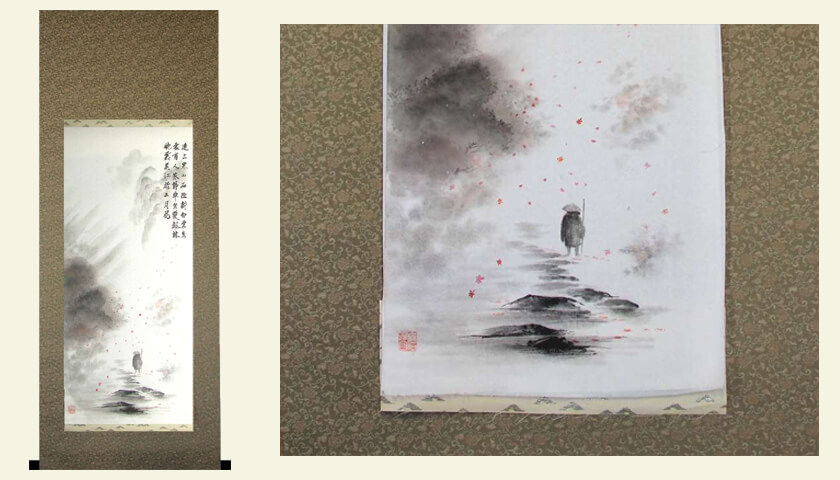
Fabric Pattern B
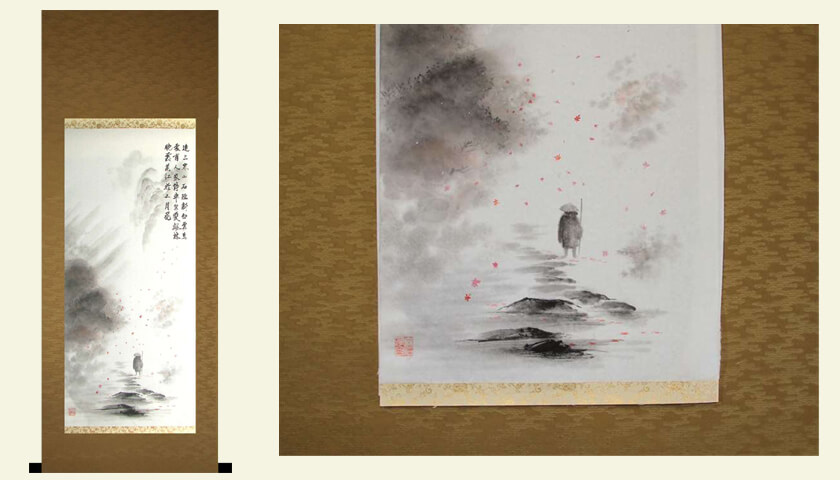
Fabric Pattern C
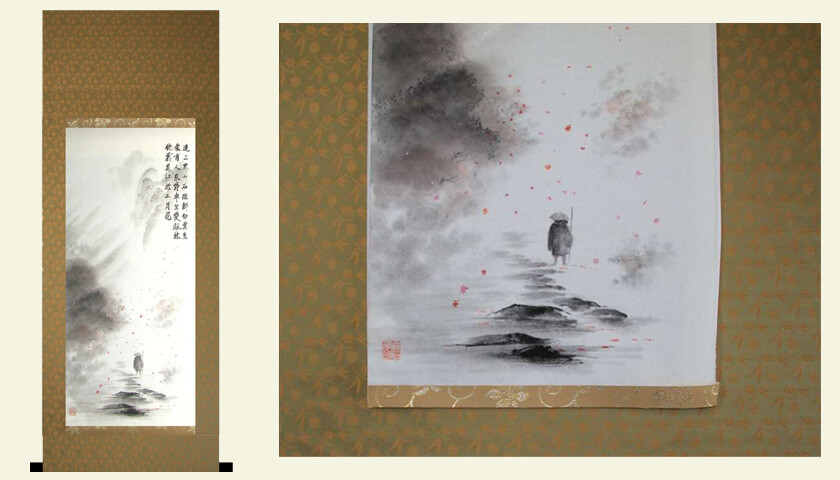
The client would like to take both “ichimonji-otosi”* and a paulownia wood box as options. We often propose to add ”ichimonji-otoshi” and most of clients, both Japanese and overseas clients choose the option.
Ichimonji-otoshi :
The act of surrounding the art work with the same fabric of ichimonji (ichimonji is a fabric attached to top and bottom of the main art work). Ichimonjii-otoshi gives a scroll sharper look to a scroll.
Please refer to :
An article on the effect of ichcimonji-otoshi is coming soon.
The client liked pattern.B but had some concerns asf ;
=Quote=
I have two questions:
– Will the painting lose a bit of its openness, if an Ichimonji-otoshi would be added?
– Isn´t the Ichimonji of B a little bit too bright? I mean, it is really impressive now and i would take it as it is!What do you think about No. B, 140cm, with Ichimonji-otoshi, but the Ichimonji with a little bit less brightness?
We see. He was worried the ichimonji-otoshi might be too loud and the painting will lose its openness. Here are our answers.
=Quote=
– Will the painting loose a bit of its openness, if an Ichimonji-otoshi would be added?
The color of ichimonji is soft toned beige with gold pattern. The color is perfect for your painting. It should blend in nicely so we think the painting will not lose its openness when an ichimonji-otoshi would be added. The color appears differently depending on the type of light during photo shooting. Also, viewing the fabric from a slightly different angle can make its color appear brighter or darker. For your checking, please find below files of close up photos of ichimonji.
– Photo on the top was taken in the room.
– Photo on the bottom was taken under fluorescent light, using a flash. The gold shines and it is brighter.
Photo taken in the room
Photo taken under fluorescent light, using a flash
– Isn’t the Ichimonji of B a little bit too bright? I mean, it is really impressive now and i would take it as it is!
An Ichimonji-otoshi part is only 3mm wide so it will not be too bright. Kindly check attached file to see how it would look when it is actually added. (Please see below.) What do you think about it?
Just for your reference, we also made another sample. (Please see below.)
Less shiny ichimonji, using the same inner enclosure of patten.B. The dark purple with silver pattern will bring out the classic & simplicity of sumi-e.
The client loved this new ichimonji and decided to make a scroll in the manner of ichimonji-otoshi.
Done Deal
Mounting for the Picture of Autumn Scene
+ Mounting Style : Maru mounting in the manner of ichimonji-otoshi+ Fabric : No. B / Ichimonji (Dark purple with silver)
+ Total Length : 140cm
+ Option : 1 paulownia-wood box+ Lead time : Approx. 2.5 months after receipt of the payment
+ Inclusive : Shipping charge by EMS (Japan mail post ), Insurance fee
+ Duty & taxes :
Please be noted that import duties, taxes, and other charges are not included in the price.
These charges are to be covered under the buyer’s responsibility.
Now, let’s get it started!
Color Fixing
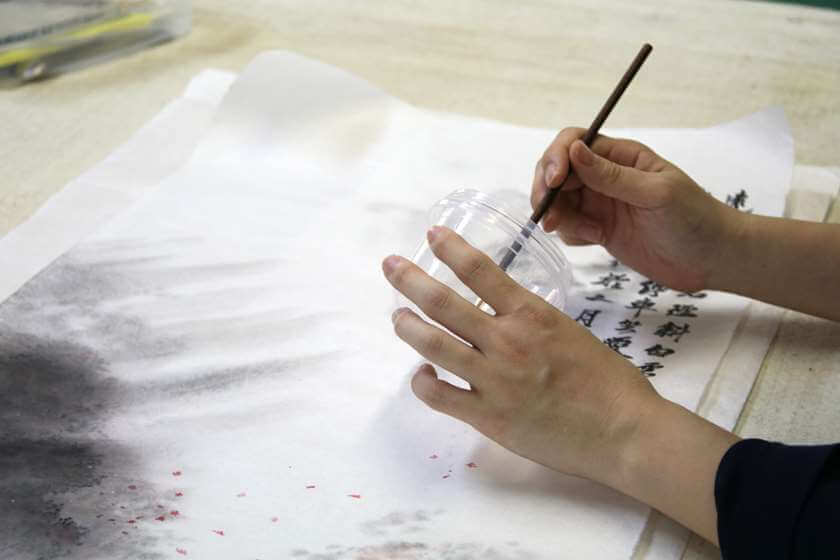
First of all, we coat the surface of a picture with a special color fixing agent to prevent color bleeding. The painting will likely bleed in the remounting procedure, especially the first time we wet it for removing old backing paper. Brush each character and all the colored part meticulously. This time, we increased the density of the chemical due to unstableness of ink and pigments.
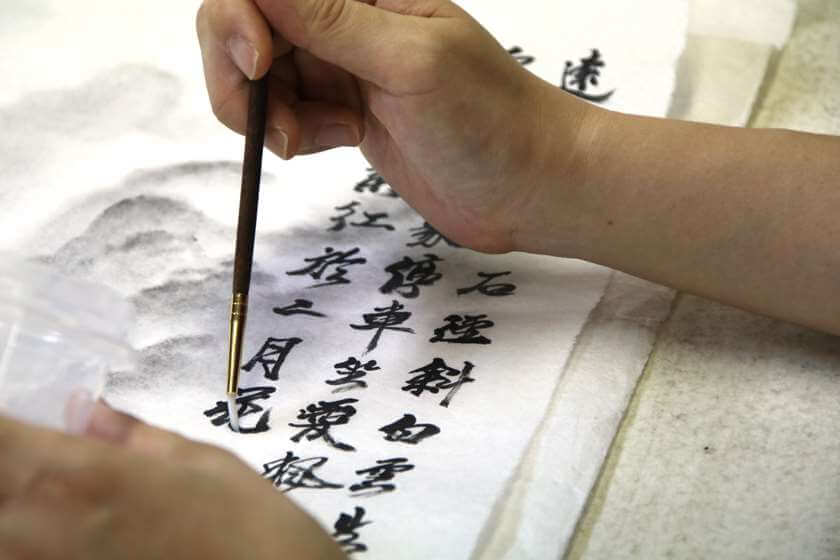
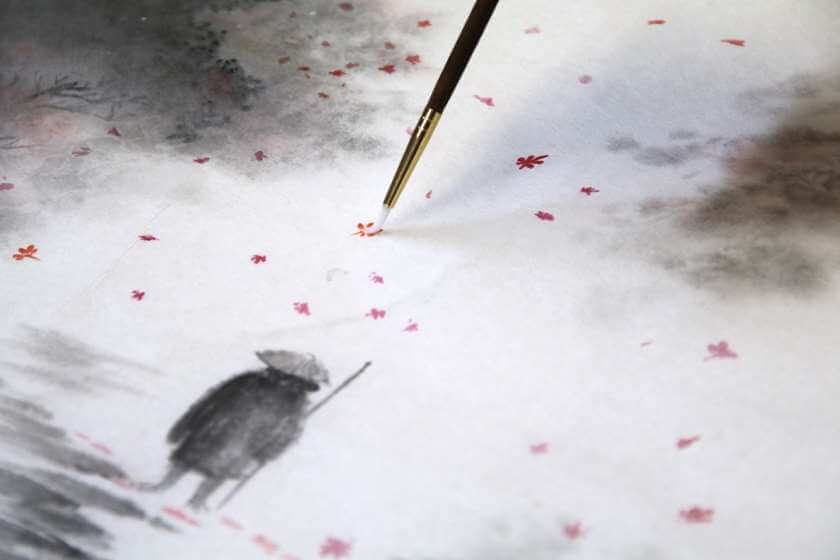
Removing an Old Backing Paper

Next, remove an old backing paper from the painting. Set the artwork face down on the table, spray water to soften paste and start peeling. The difficulty depends on the condition of the artwork and the adhesive force of paste used in the former mounting.
The old backing paper was removed smoothly since paste was not so strong.
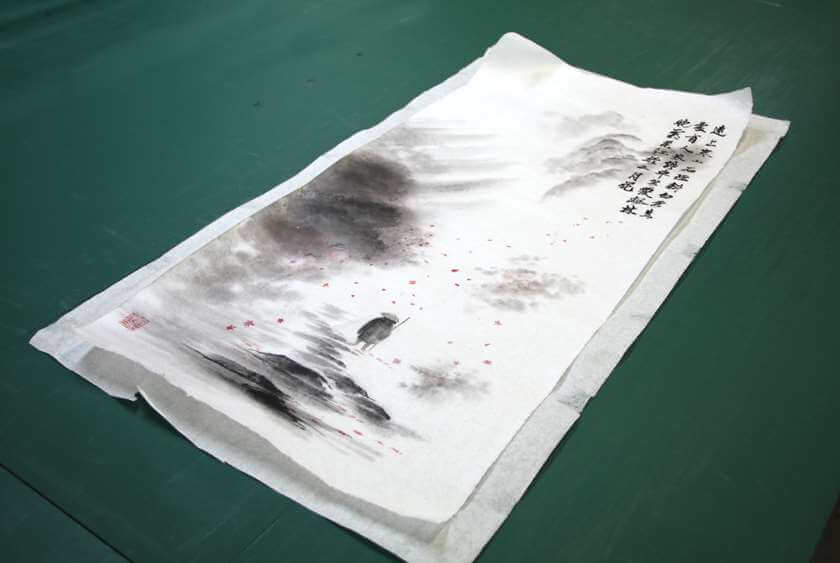
The First Backing of the Main Work
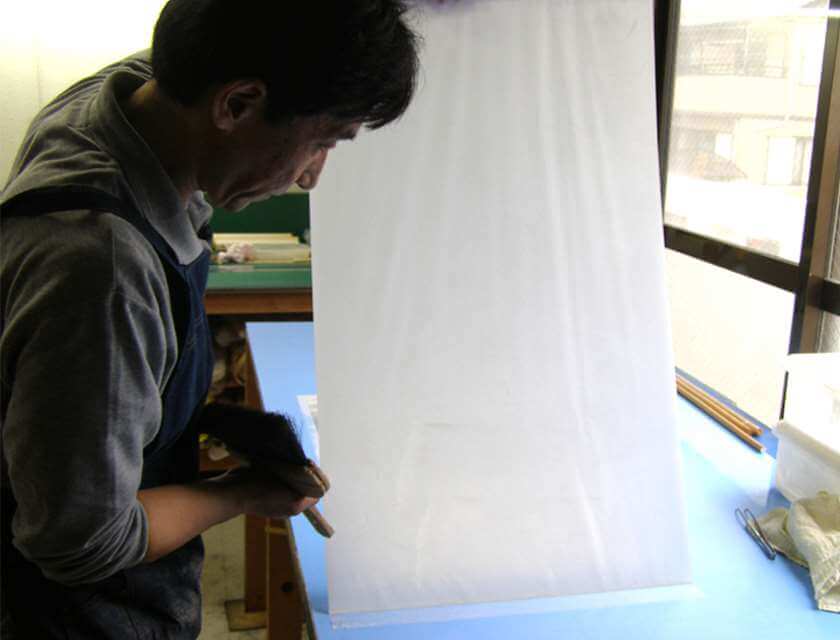
Backing (called “urauchi”) is the act of applying paper (washi- Japanese paper) to the back of paper, silk, or fabric with paste for reinforcement. In mounting a “kakejiku” (hanging scroll), the first backing called “hada-urauchi,” is applied directly onto the back of the main work. It plays an important role to prevent a Japanese paper from expanding & shrinking. Also it prevents warp/buckle under animal glue contained in sumi ink. In this process, relatively thin, flexible but firm paper is used.
Give proper amount of water to the artwork. A paper under the artwork is a protection paper called Ategami, that is used for protecting the main art work during mounting and restoration. Also, it is used to cover the part where direct contact with the hand needs to be avoided.
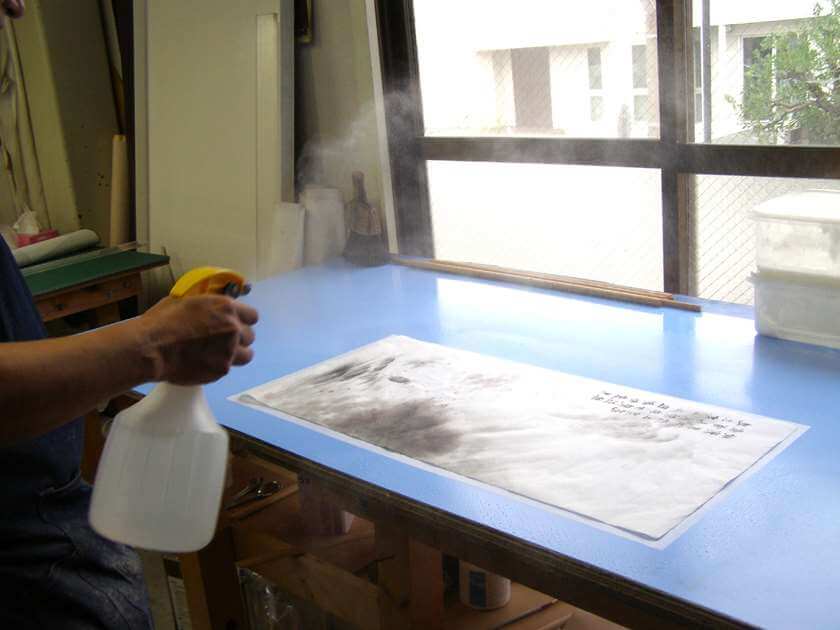
With brush, push the air out that is in between an ategami and the artwork, then smooth out the whole artwork.
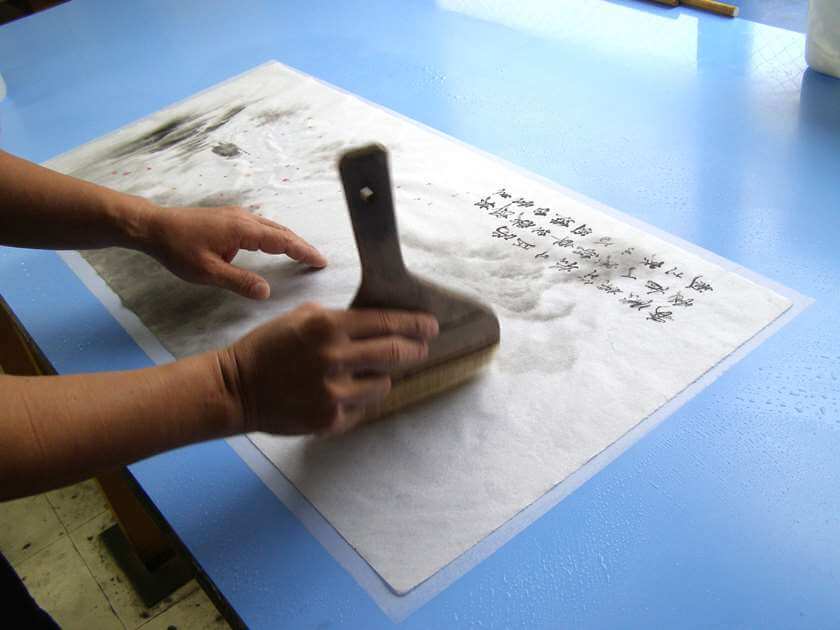
If color fixing is not done properly, sumi ink and pigments will bleed at this stage too since the artwork is directly rubbed with a brush. Also, too much water and too much touching of the painting become the reason for color bleeding.
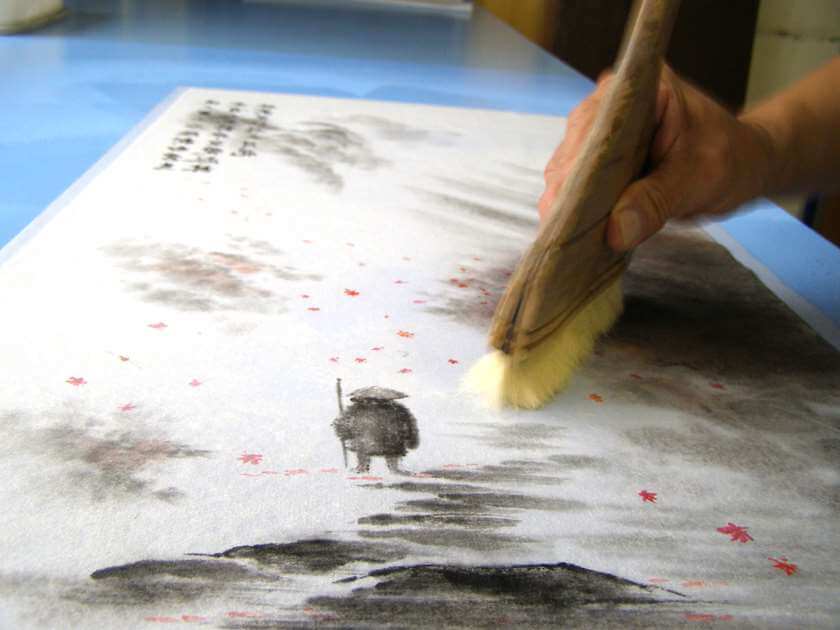
With brush stroke onto the paste-applied backing paper, our craftsman attach it to the back of the main art work.
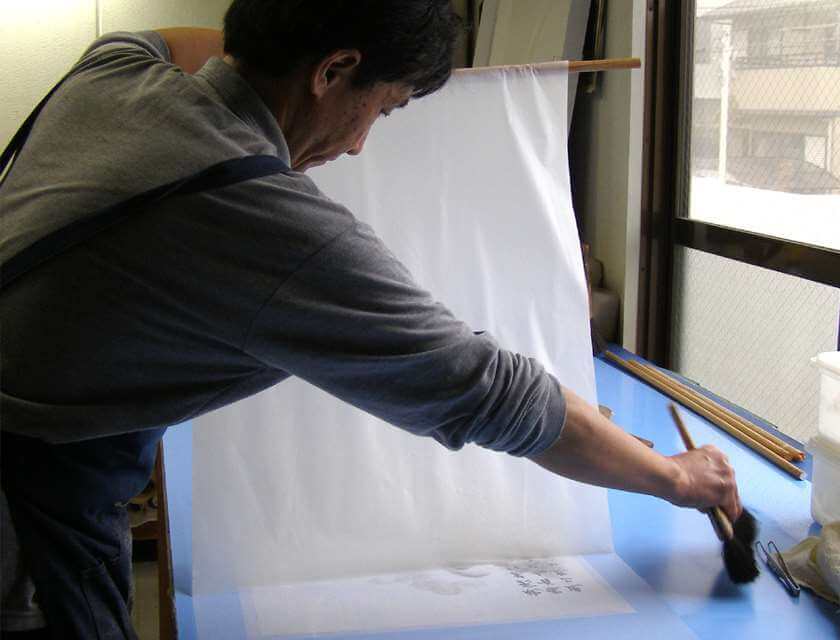
Be careful not to let the backing paper wrinkle.
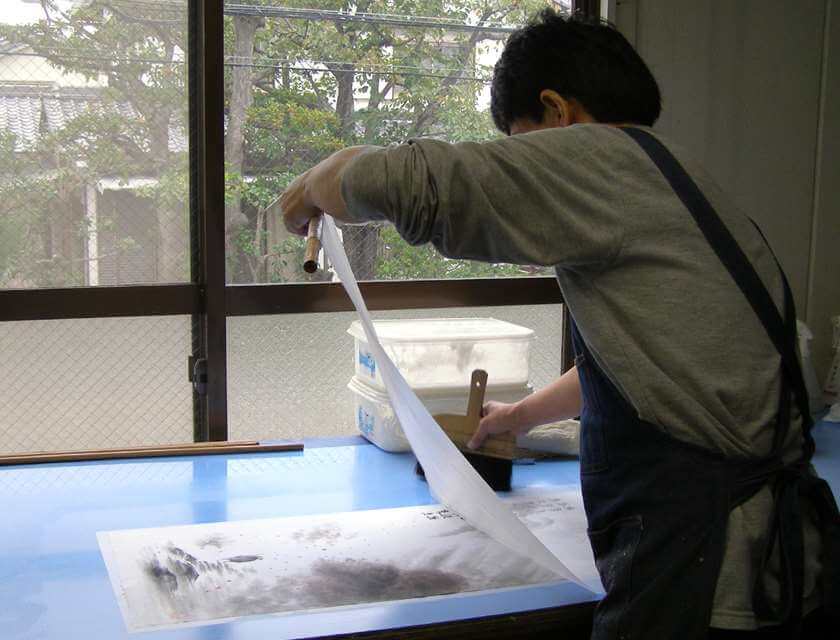
After attaching the backing paper, its surface is tapped with the brush for adhering the backing paper firmly to the main work. Keep tapping until they adhere to each other completely.
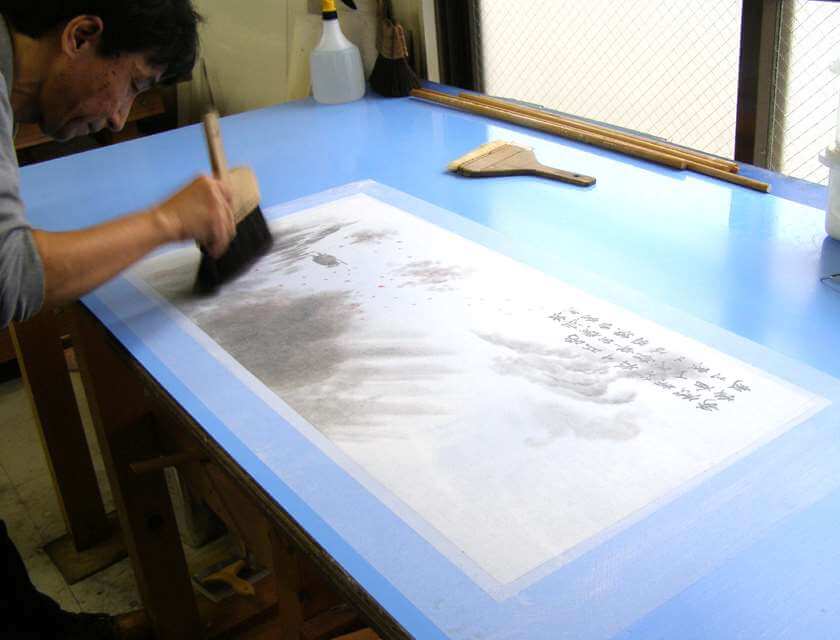
Drying on A Wooden board
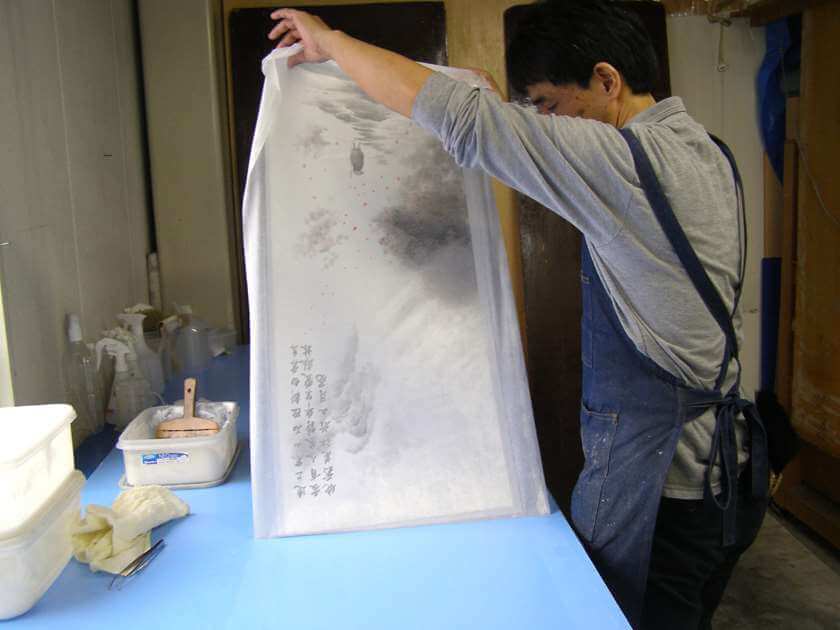
Once the backing is finished, put the main work on a wooden board and let it dry. This process is called “kari-bari”. It stands for “temporary sticking”.
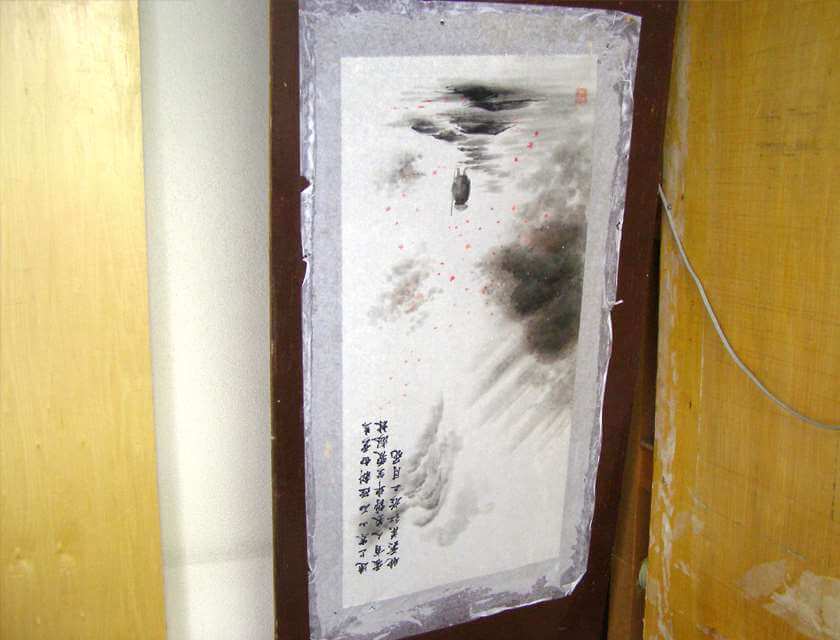
Cut and Join / Kiritsugi or Tsukemawashi
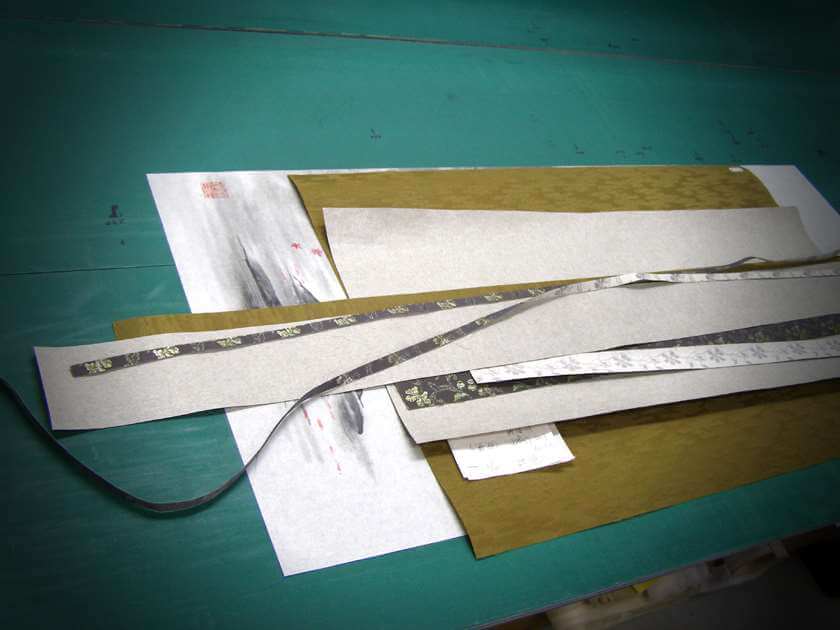
These are a set of mounting fabrics prepared for cut and join. Once the backing paper is completely dry, we start attaching mounting fabrics.
Attach ichimonji-otoshi first.
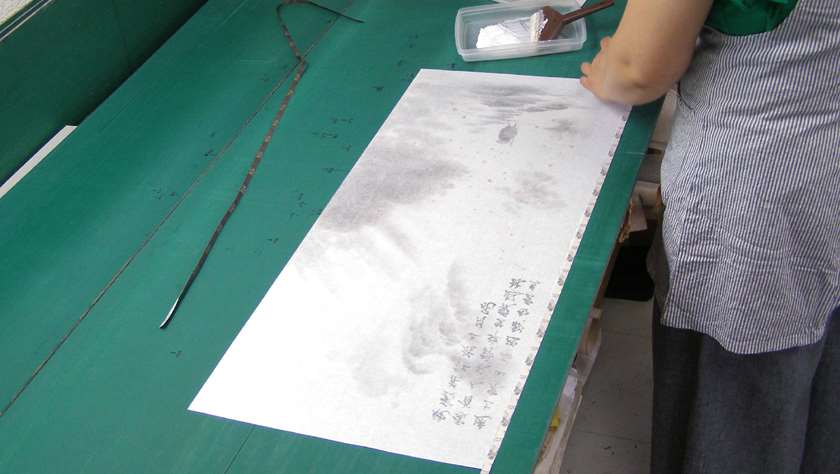
Then, ichimonji next.
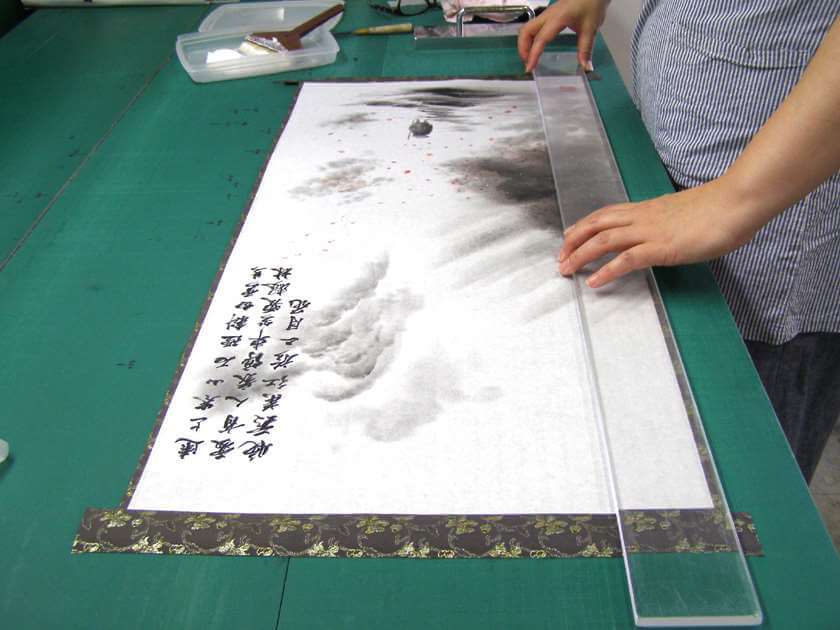
Attach the pillar of inner enclosure (nakamawashi) on ichimonji-otoshi.
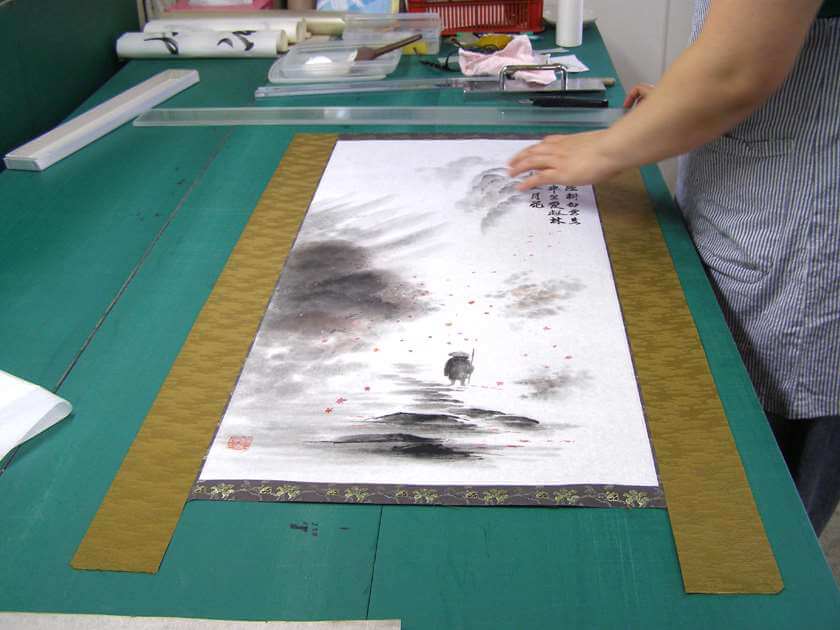
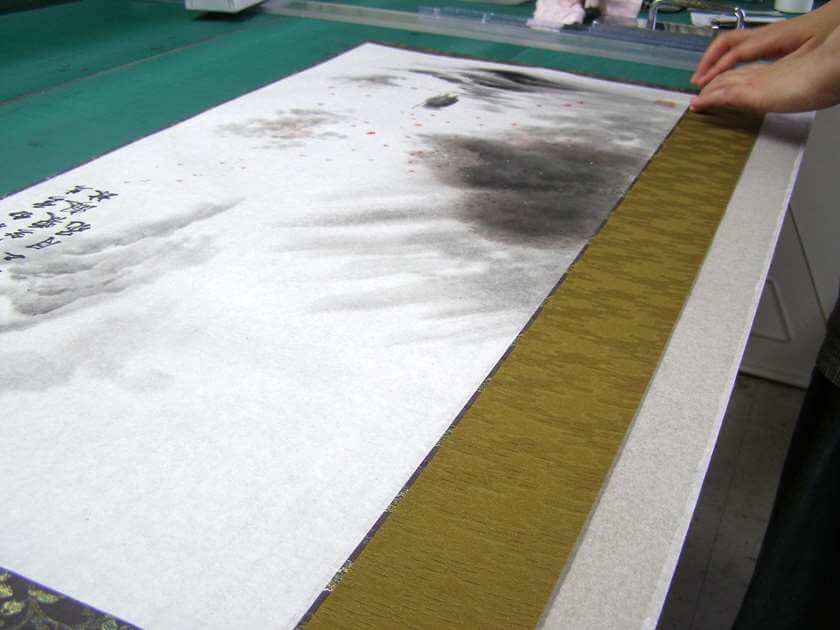
Attach the top and bottom of inner enclosure (nakamawashi).
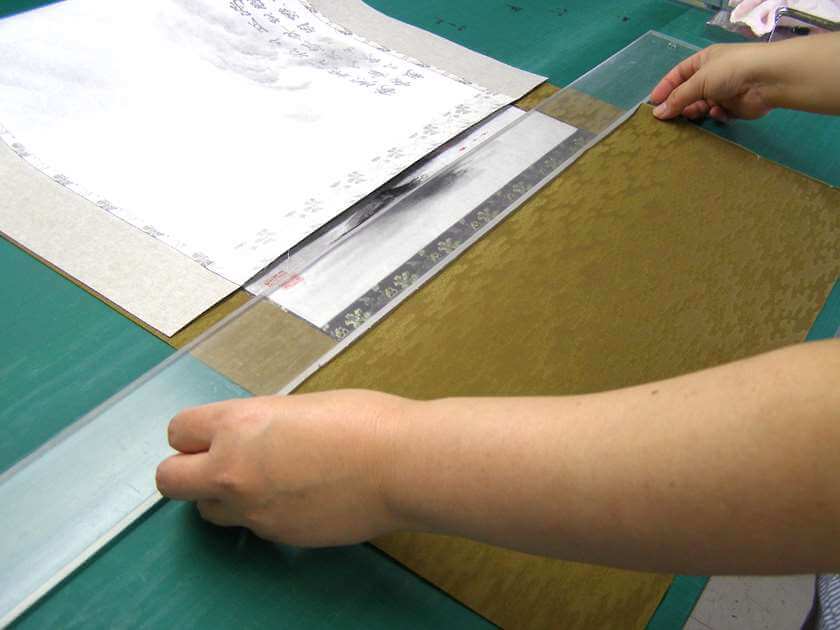
This is the backside of the work after all the mounting fabrics (8 pieces in this case) are attached.
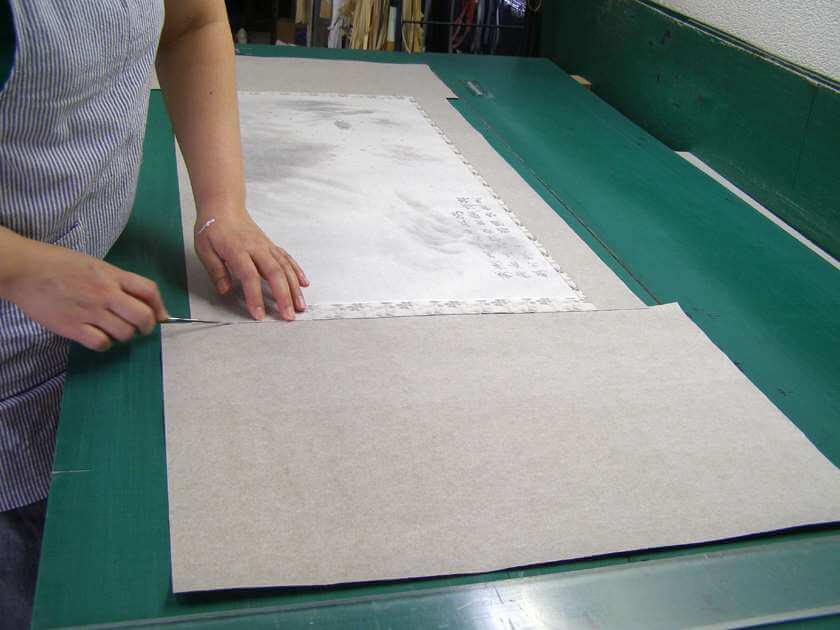
Once it is done, we double check to see if there is any problems, e.g. Remove paste that came out of the sides and cut loose threads.
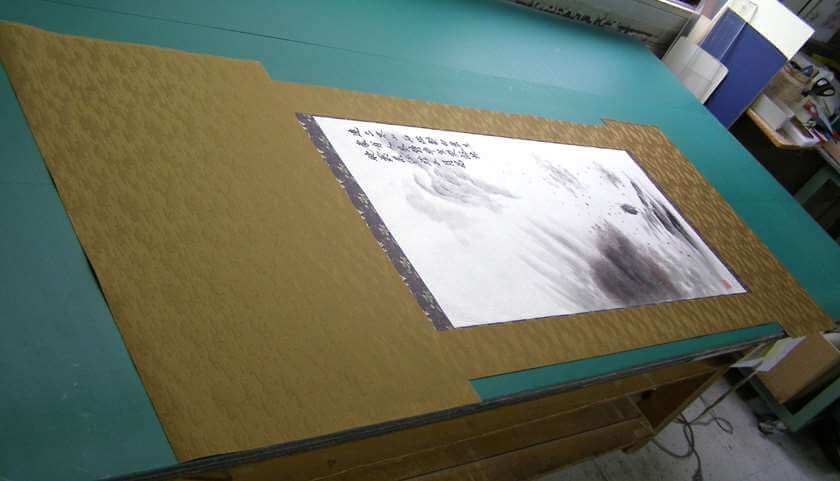
Cut and join is done.
The Second Backing
The second backing is called “mashi-urauchi” (subsidiary backing of the main work and mounting fabric). It is added to maintain balance between the main work and the mounting fabric, in terms of their thickness and strength.
Folding over of the Edge / Mimi-ori
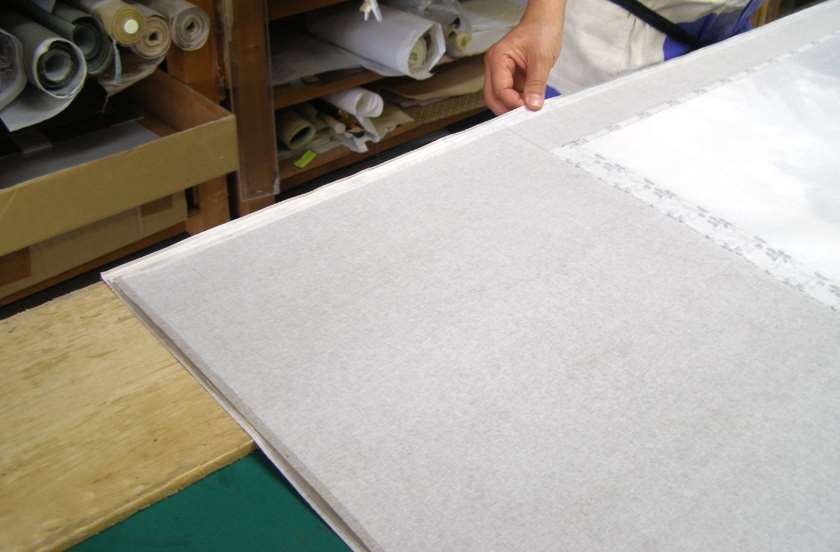
Mimi-ori is an act of folding the left and right edges of a hanging scroll back approximately 3-5 mm. This width differs according to the size of the hanging scroll. It is executed after cut-and-join before the final backing.
Prior to mimi-ori, make a slight slit in both sides so it will be folded over easily.
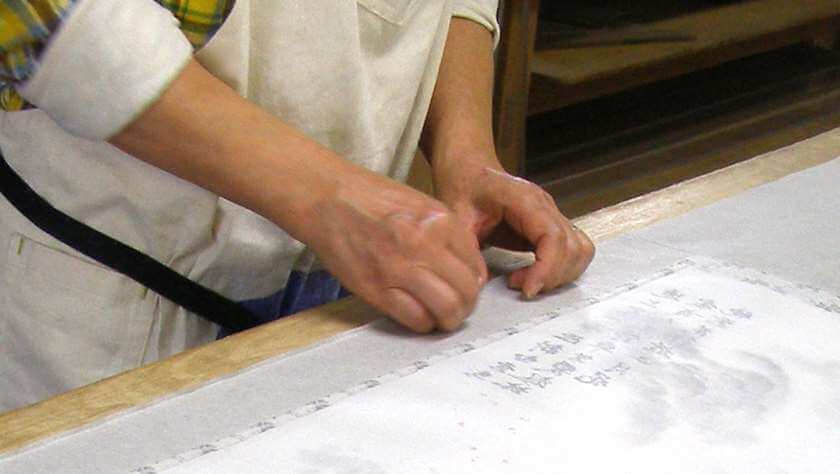
Apply a thin layer of paste to the edge.
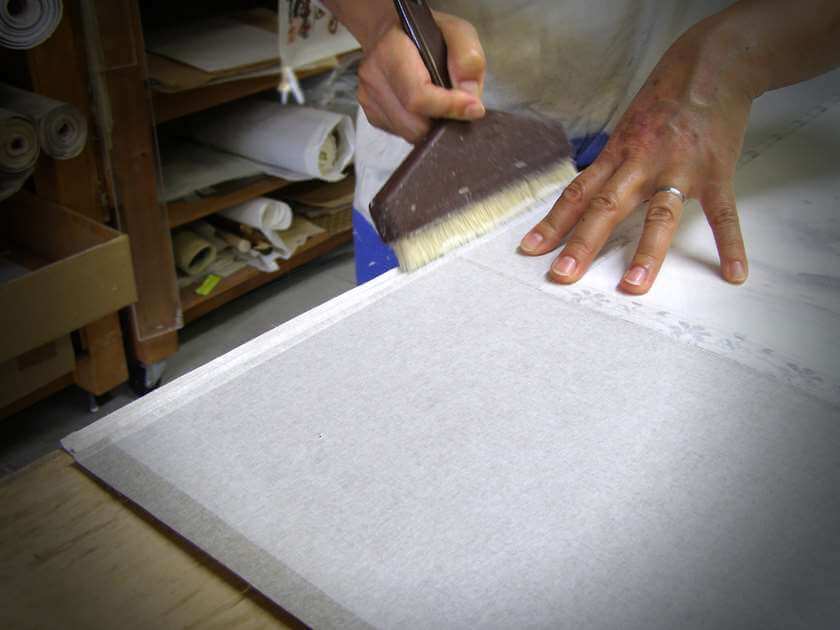
Fold over the edge.
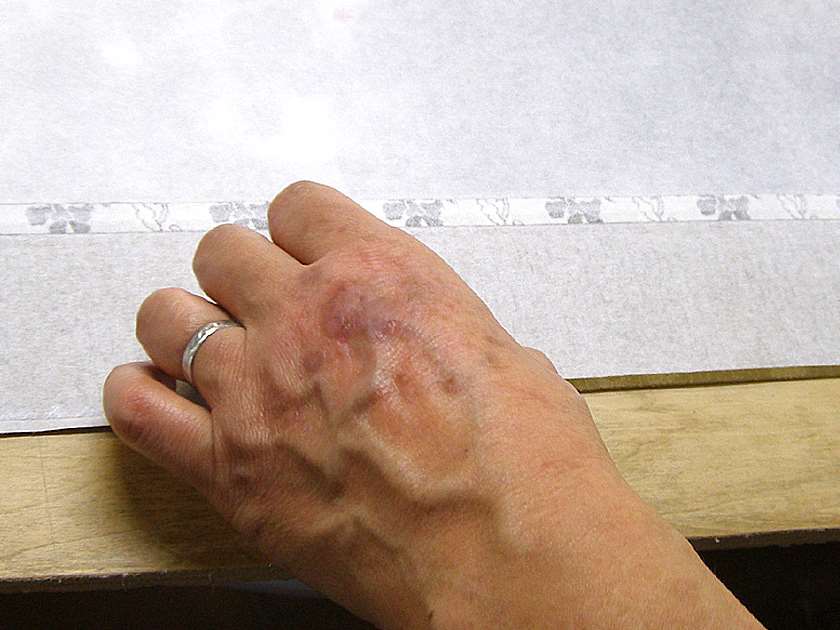
Folding over the edge (mimi-ori) is done.
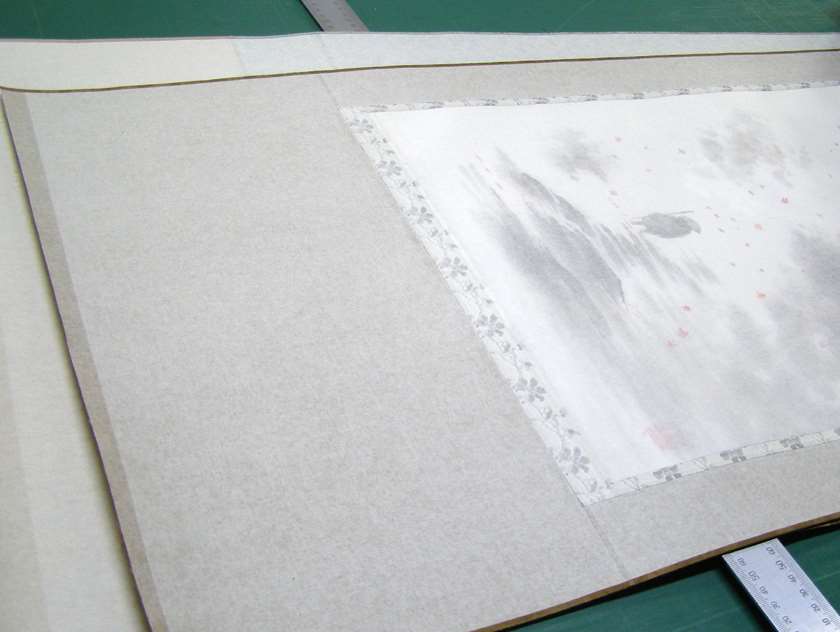
This is executed for preventing loose threads of mounting fabrics and to enhance strength of the edges for a scroll.
The Final Backing
The final backing is called “sou-urauchi.” It is added to obtain a flat and smooth finish, so that the kakejiku can be rolled up smoothly.
Finishing
A hanging rod (hassou) is attached to the top of the kakejiku, while a roller rod with knobs is attached to the bottom. (jikubou) Ring tacks are hammered in the hanging rod and a hanging cord and a wrapping cord are passed through them.
Apply paste to the hassou bukuro*
*Hassou bukuro is the upper end of the top of a hanging scroll, the part around which the hanging rod is wrapped.
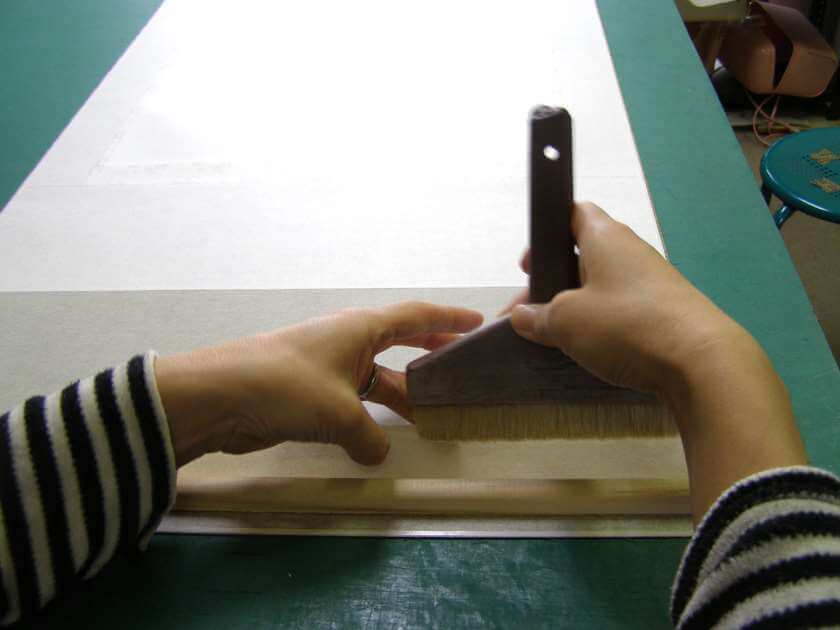
Roll the hanging rod with the hassou bukuro and attach firmly.
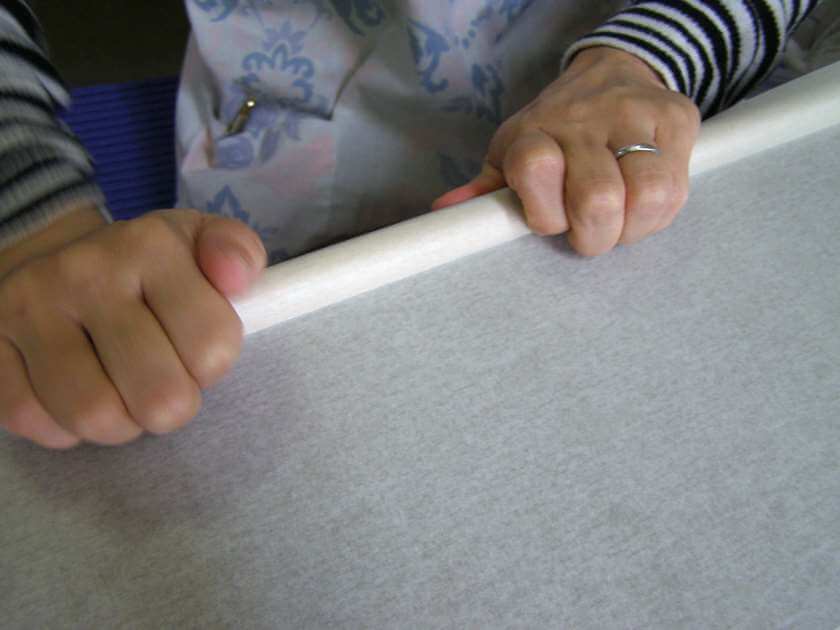
Ring tack / Kan is a tack to tie and fasten the hanging cord. The hanging cord is passed through its loop-shaped head. It is attached to a hanging rod together with a decorative metal washer (zagane).
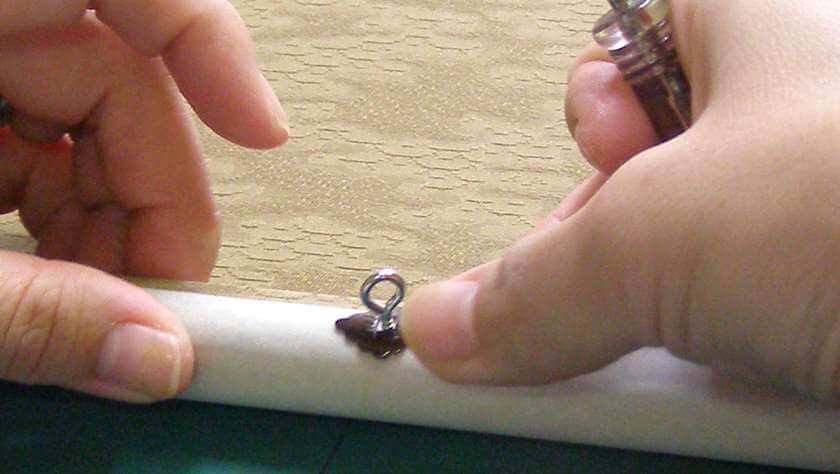
Apply paste to jikubukuro*.
*Jikubukuro is a lower end of the bottom portion of a hanging scroll around which a roller rod is wrapped and fixed.
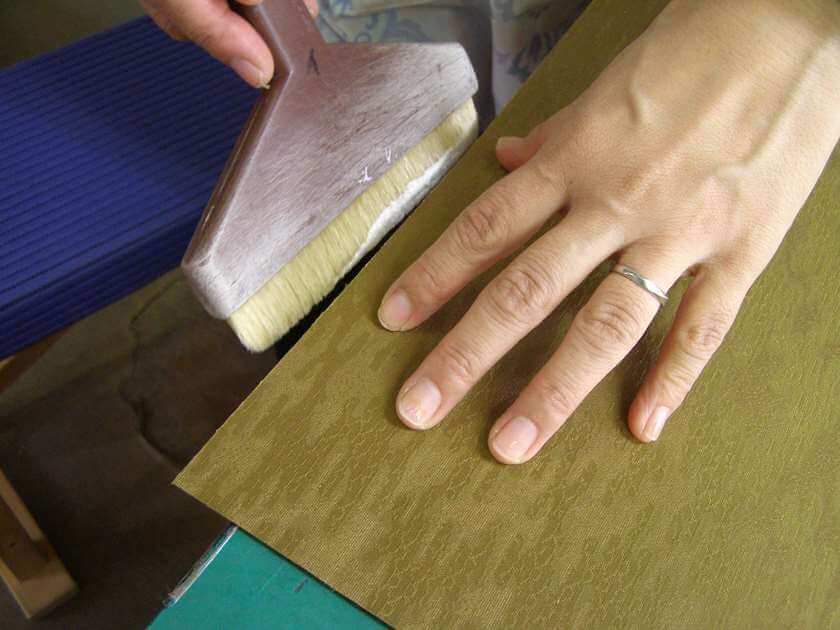
Attach a roller rod / jikugi or jikubou. It is a rod around which a hanging scroll is rolled. A roller rod with roller knobs (jikusaki, jikushu) attached to both ends is called “jiku”.
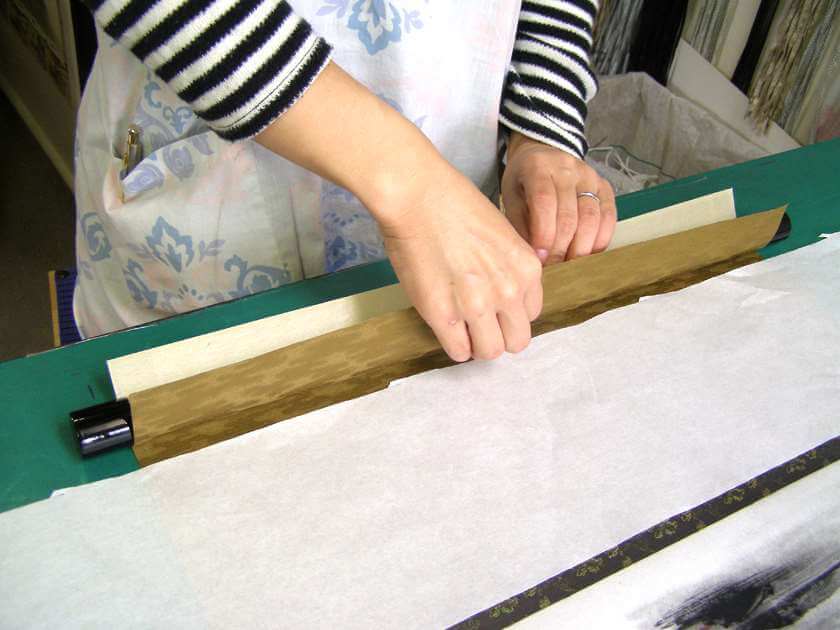
A roller rod cannot be seen from the outside because it is wrapped with jikubukuro.
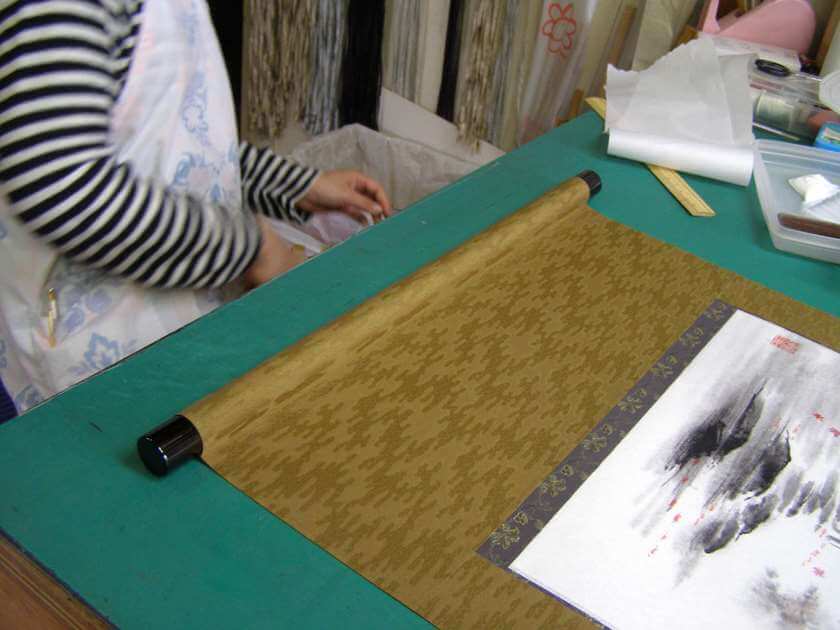
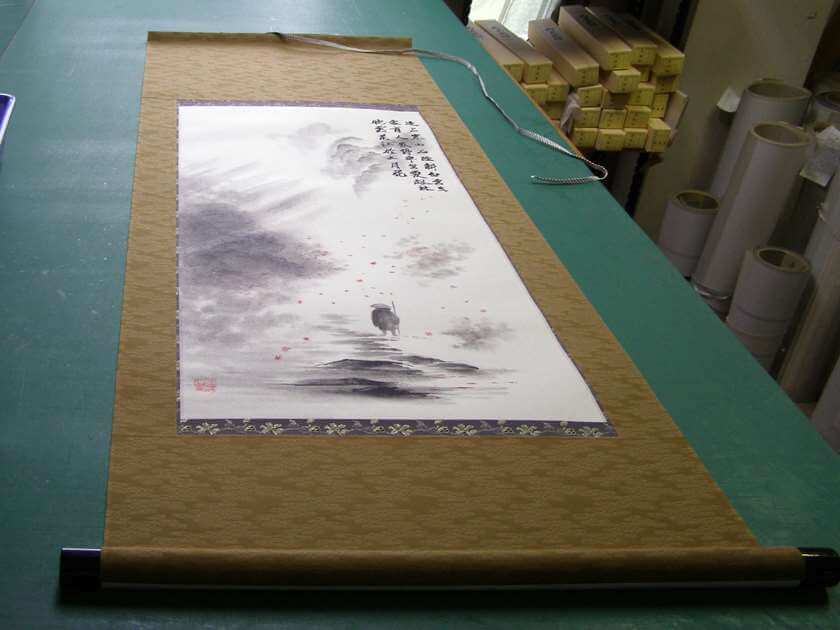
We look the entire scroll over to ensure everything is perfect.
Here is the finished scroll!!
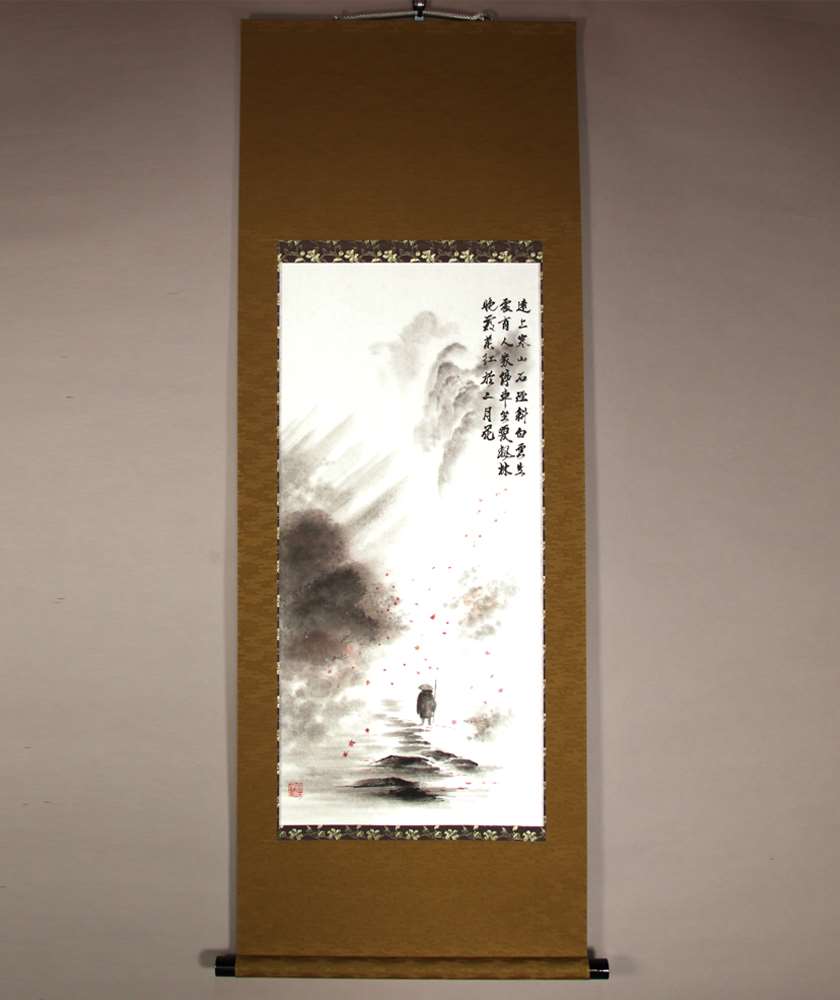
This ichimonji (Silver pattern on dark purple) goes well with sumi-e painting. The silver color accentuates the white background of the painting.
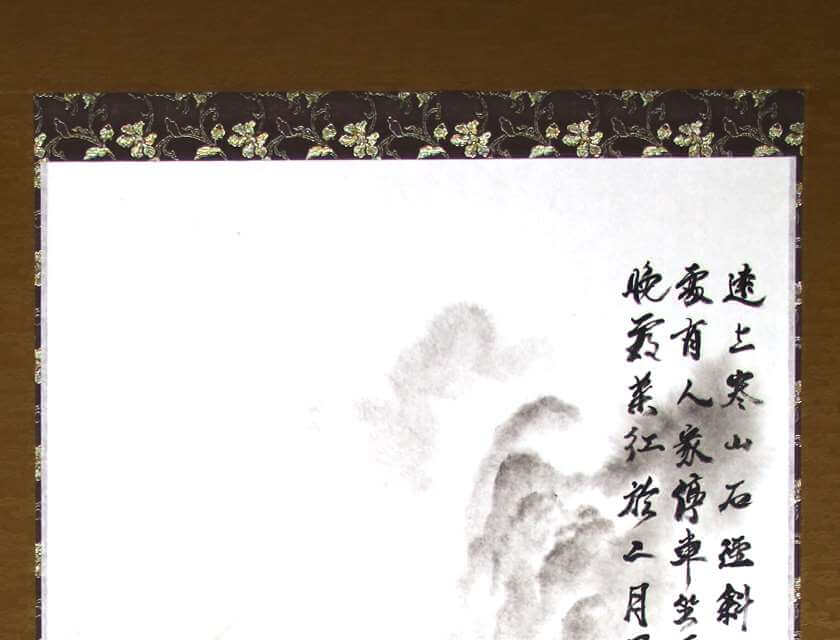
We were so relieved there was no color bleeding after all.
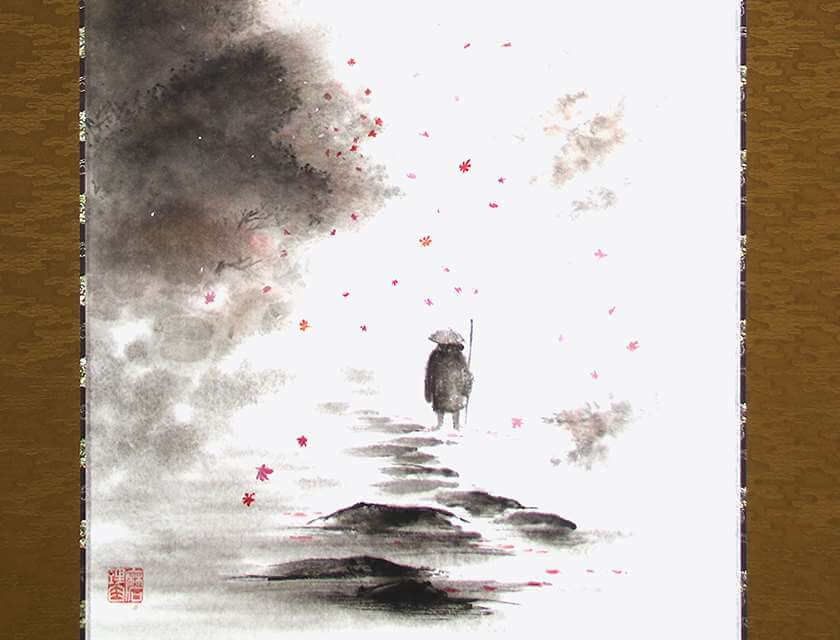
The brown inner enclosure matches the theme of the painting and make us feel a deepening Autumn. Before shipping, we advised the client that the scroll is finished with above picture and his reply was “Amazing!”. Thank you for your compliment.
Lovely Comments from the Client
A few days later, we were informed from him that the kakejiku has returned to him safely.
=Quote=
Today i received the hanging scroll – it is superb!
I enjoy the the artful handcraft, aesthetic sense, your advice and the quality very much, thank you.
I´m looking forward for the next painting i will send to you.
We are very happy to hear that the hanging scroll arrived safely and that the client liked it! We wish we could see the scroll with his future bonsai displayed in his tokonoma someday. We look forward to working with him again too. It will be our great pleasure!
Lastly
Bonsai and hanging scrolls. They are the Japanese traditional arts that Japan proudly believes to be among the world’s best and they share the common ground in which both stimulate our imagination to feel more than what we actually see. The combination of bonsai and scrolls can make the ground well known together. We hope the appeal of hanging scrolls will be conveyed to all over the world along with the appeal of bonsai.
Thank you for reading this post.

